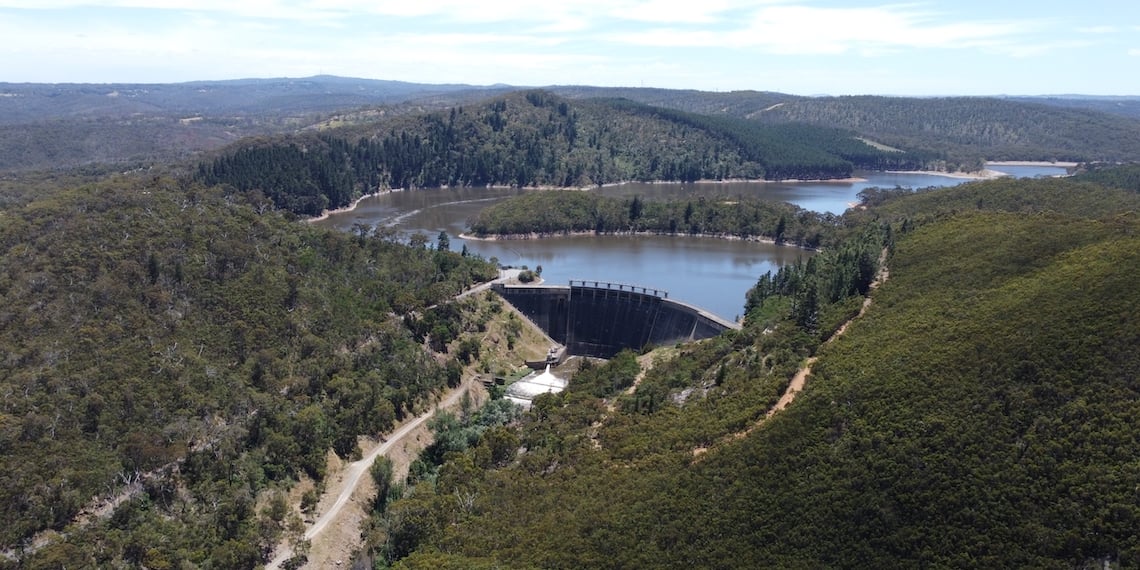Focus on climate resilience leads major dam upgrade

As extreme weather events continue to break records in Australia and wreak financial havoc, climate resilient infrastructure will be key to mitigating impacts moving forward. One utility has spent the past decade considering how to fortify its largest asset against extreme events.
South Australia’s largest reservoir and dam is set to receive a major upgrade in line with renewed national safety standards, with SA Water revealing a proposed design that will see the asset safely pass up to a one-in-five-million-year weather event.
Constructed between 1932 and 1938, the 50-meter-high asset is an important storage for both natural inflow and water pumped from the River Murray, with a total capacity of around 46 billion litres, providing around 40% of water for metropolitan Adelaide.
SA Water Sustainable Infrastructure General Manager Amanda Lewry said the upgrade plans have been a big piece of work for the utility, more than a decade in the making.
“Our upgrade of Mount Bold’s dam is the culmination of years of planning and will be one of the largest capital projects in our history once completed,” she said.
In developing the upgrade plans, SA Water has focused on enhancing dam safety in the face of extreme weather events, particularly in light of new safety guidelines.
“Mount Bold has had a lower risk compared to other dams, and as it’s the most complex upgrade in our portfolio, that has required significant long-term planning,” she said.
“Rightly so, the refreshed national safety guidelines set by the Australian National Committee on Large Dams are particularly conservative, and take into account the most extreme weather scenarios to ensure we’re covering all bases.”
Designing out risks
Lewry said the proposed design has thought through various options to ensure the upgraded dam can safely pass extreme wet weather events, but has also focused on simplifying operations to reduce risk.
“To elevate the dam’s safety, we’ll be constructing significant concrete protection downstream of the dam to reduce the risk of erosion, while strengthening the wall with new concrete to increase its capacity to withstand earthquakes and extreme flood events,” she said.
“But we've also looked at options to make the operation of the dam simpler to lower risk. Simplifying the operation of the dam will mean there’s less chance of something going wrong during extreme weather events.”
The proposed design features a three-stage spillway, with a primary spillway slot three metres wide by 5.6 metres high, which will replace a series of gates that currently control the release of water.
The new design will enable a self-managed flow release, providing flood attenuation and minimise the impacts of flooding for downstream communities.
“This is more efficient, allowing for the retention of water during extreme weather events, due to the dam’s ability to temporarily store more water and release it at a rate that’s three times slower compared to having all the gates open,” she said.
“When the reservoir is already full, the dam’s primary spillway will play this role up until around a one-in-a-hundred-year event, where the other two spillways will be activated to help release water and preserve the dam’s structural integrity.
“Inherently, this will provide the dam with a greater ability to minimise the impact to residents downstream by releasing water more steadily.”
Researching resilience
One of the most important aspects of developing the proposed design was ensuring a deep understanding of the assets surrounding topographical make-up, Lewry said.
“Since 2010, we’ve been methodically working through the site’s nuances, such as the surrounding geology, flood hydrology and topography, to ensure the final design achieves the greatest outcome for dam safety,” she said.
“Understanding how the dam is anchored into the surrounding earth is incredibly important because, as that geology changes, it also changes the asset's design requirements.”
In 2020, the 46-billion-litre reservoir was gradually emptied to enable detailed investigations of the intake structure, and an upgrade of equipment used to isolate the dam’s valves and pipework.
Lewry said the utility has also facilitated comprehensive modeling to test how the dam would perform in different scenarios with a focus on challenging design solutions against extremes.
“We're always looking at challenging ourselves,” she said.
“We have an amazing challenge panel made up of experts in quite specialised fields whose job it is to challenge all of our decisions. We are finding that process incredibly valuable.
“We’re now optimising our concept as part of the detailed design phase, with scope for further refinement to ensure we’re delivering a cost-effective project.”
Major construction is expected to start in coming years and take several years to complete.



